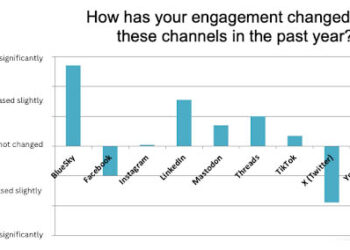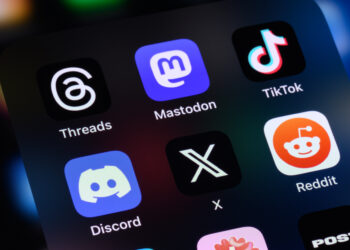
- Image via Wikipedia
Persistence may not be the key to success in an attention economy. In fact, it appears to do long-term harm, a new study suggests.
Fang Wu and Bernardo Huberman, both from the Social Computing Lab at HP Laboratories in Palo Alto, California, researched the production histories and success of over 10 million videos submitted by over half a million producers on the online video site, YouTube.
Their manuscript, “Persistence and Success in the Attention Economy,” was submitted to the arXiv on April 2nd and is freely available.
The researchers defined a “success” as a video that ranked in the top 1% based on downloads to all videos submitted in the same week. Seven percent of all producers earned a successful title sometime within the study period and 21% of these successful producers earned it with their first video.
If you think that success is just the luck of the draw, we should expect that persistence in uploading videos should pay off. In fact, it does just the reverse.
While the average quality of repeat submissions increases steadily with each successive upload (quality here being counted as the average star ratings a video receives by its viewers), the likelihood of having a success actually decreases with increasing submissions.
This result is puzzling since we assume that producers learn from past failures and improve their technical and marketing skills which successive submissions. The main point of this of this article is that persistence can be harmful to future success.
Does this study say anything about academic publishing? Substitute YouTube for the name of your favorite journal and there are many uncanny similarities:
- Like YouTube producers, academic authors operate in an attention economy where success is measured by the ability to attract attention.
- Academics want their work to attract the attention of their peers. They want to be read widely and cited profusely. They want their articles published in prestigious journals and be associated with the great works of others. They want editors to highlight their work in editorials and be promoted through press-releases. A best-article award may not come with any money, but for an academic, it’s worth more than gold.
- Many publishers have added YouTube-like post-publication evaluation tools to their site, listing top-downloaded articles, allowing readers to rate articles by stars, leave comments, or post a summary on a social networking site, among others.
But this is where the similarities stop.
While persistence may not work for YouTube artists, it’s a behavioral strategy that works for most academics. It’s not necessary to publish consistently cutting-edge research in top-tier journals to be considered successful. Publishing unremarkable findings in second-tier journals is good enough for most academic promotion and tenure purposes.
Perhaps the problem with translating the findings of YouTube to academic publishing is in the definition of success, which is defined as the videos which ranked in the top 1% of downloads. This definition necessarily limits behavioral analysis to academic superstars. It ignores the fact that specialization allows many academics to be local stars in small fields and avoid competition with global stars in immense fields.
Not all of us can be superstars, but many of us do shine brightly.
Discussion
8 Thoughts on "The Paradox of Persistence in an Attention Economy"
Interesting post. Would you please cite as many examples as you can of peer-reviewed journal sites where publishers allow “readers to rate articles by stars”? Thanks in advance.
Ted, you seem to be focused on a single detail in a long series of examples intended on illustrating that publishers have adopted post-publication evaluation tools, similar to YouTube.
But to cite the example I was thinking of when I wrote that sentence, please look at an article published in PloS One, e.g.
http://www.plosone.org/article/info%3Adoi%2F10.1371%2Fjournal.pone.0004901
Thanks. I didn’t realize any publishers were doing this. It will be interesting to see how many follow PLoS’s lead. Other than the most-downloaded usage reports that a good many sites are publishing these days (have been for many years), currently I don’t see much post-publication evaluation being supported by STM journal publishers, certainly not of the explicit, interactive kind. I’m perfectly willing to be corrected, but it still seems much more the exception than the rule.
Of the PLoS journals, only PLoS One allows the post-publication star rating system. Perhaps it is because PLoS One conducts only “lite” editorial review and not full peer-review.
One also needs to register with PLoS in order to rate articles and I wonder if this is to prevent authors gaming the system by rating their own articles multiple times.
Correction #1: 6 out of 7 PLoS journals have the entire system in place for comments, notes, ratings, trackbacks, and article-level metrics. The 7th is coming soon.
Correction #2: the nasty myth that PLoS ONE peer-review is “lite” needs to be eradicated before it spreads too far out – check out what our editors say about the reviewing process in the interviews: http://everyone.plos.org/tag/interview/
Not just that the peer-review at PLoS ONE is as rigorous as anywhere, but many feel that the elimination of the “novelty and earth-shakiness” criterion actually makes the peer-review more rigorous than in GlamourMagz.
I wonder what these post-publication evaluation tools will do to the ranking of journals. Current rankings are based on citations which, of necessity, take a while to percolate through the system.
Readership of individual articles could not be measured. Now that many journals are online, and many academics access articles electronically this changes.
Do we value reading as impact? Or must it result in citations?
And with the ease of searching electronic journals for relevant articles, do readership (and citation) patterns shift?
If the point of publishing is to communicate with peers (which I agree it is), it is this reach that is important. New tools seem to offer the possibility of measuring reach more quickly and adjusting publishing strategies accordingly.
The observation in this study seems to validate the fact that novelty beats craft a fair amount of the time. Something new that captures imagination (in popular culture) or that reveals new findings (in science) beats something that is familiar, known, or customary, no matter how well-crafted.
Novelty drives early success, craft can’t sustain it. Nothing novel about that!
![Reblog this post [with Zemanta]](http://img.zemanta.com/reblog_e.png?x-id=1a52ca03-d2e5-465b-bc07-7468723e331d)


